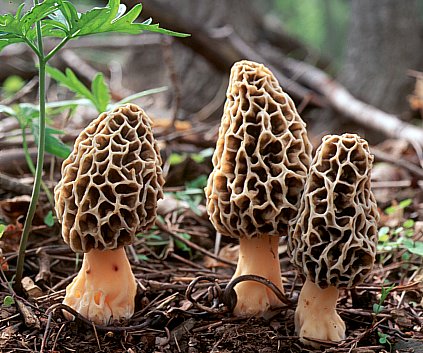Elite life

Mushrooms
Morchella
║ Mushrooms ║
Fire Morel, Black Morel (Morchella elata)

Pileus: Cap 2.0-8.0 cm tall, 2.0-6.0 cm broad, narrowly to broadly conic, occasionally more rounded, i.e. obtuse-conic to ovoid-conic; surface of parallel to meandering ridges and cross-ribs, pubescent when young in some forms; color at first greyish to ochre-brown, occasionally pinkish to blackish overall; with age the ridges dark-grey to blackish-brown, the pits lighter, i.e. ochre to grey-brown; margin when young, overlapping the stipe attachment, less so in age; context whitish, thin, firm, brittle, interior hollow; odor earthy to fungal; taste not investigated.
Stipe: Stipe 2.0-7.0 cm tall, 1.5-3.0 cm thick, hollow, equal to enlarged above and below, the base with longitudinal folds; surface typically whitish to ochre, pinkish to blackish in some forms, pubescent, becoming furfuraceous in age.
Spores: Spores 19.0-24.0 x 11.0-15.0 μm, ellipsoid, smooth; spores creamy to pale-tawny in deposit.
Morille Comestible (Morchella esculenta)

Fruit body 6-20 cm high, very variable, fertile head round to ovoid or obtusely conical, pale yellowish-brown darkening and browning with age, ridges acute and forming an irregular honeycomb around the angular pits; stalk minutely scurfy, slightly swollen at the base and longitudinally furrowed, whitish to ochraceous cream. Asci 330 x 20 μm. Spores cream, broadly elliptical, 16-19 x 8.5-11 μm.
║ Mushrooms ║